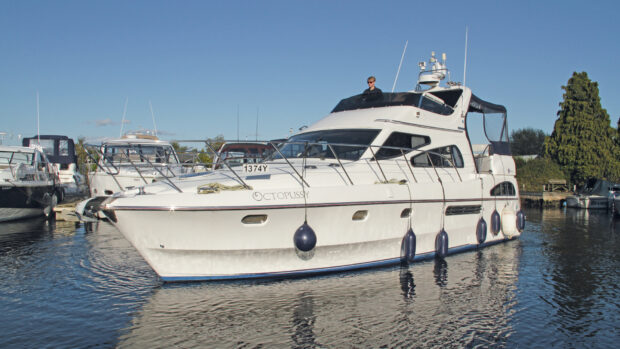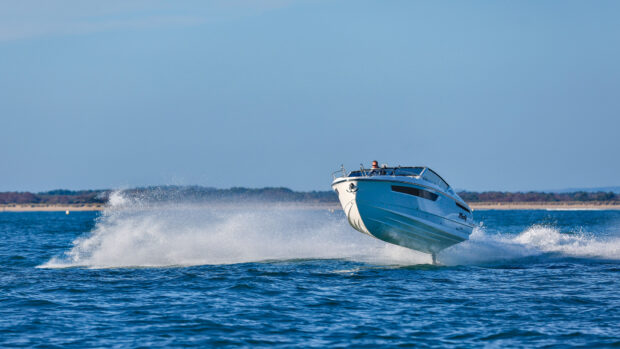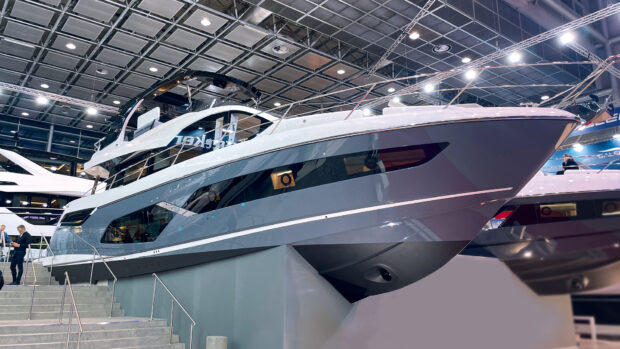Alex Smith heads to France’s Beneteau HQ for a UK exclusive on what might just be the best Swift Trawler yet, the Beneteau Swift Trawler 54
Saint-Gilles-Croix-de- Vie might seem like an unassuming little town for a boatbuilder of Beneteau’s stature, but as you cast your eye over the river, the clues are there. Whether for commerce or pleasure, every boat seems to come with a sheltered pilothouse and a big aft deck, full of flags, floats, lines and buoys.
It’s clearly a hotbed for sea fishing and yet in spite of the town’s reputation for some of France’s most delicious sardines, it’s not actually a fishing boat we’ve come to see. We’re here to see a boat Beneteau describes as a high-volume, long-distance cruiser built for weeks, rather than merely weekends, away – a boat so new that, to this point, it has been witnessed by just one other member of the world’s press.
It’s known as the Swift Trawler 54 and as it dozes in the sun, its flared ‘block-out-the-sun’ flybridge perched on a vertical structure dwarfing the boats that surround it, what’s particularly striking is that it looks pretty much like every other Swift Trawler we’ve seen – and that’s at once a surprise and an inevitability.
After all, there’s a slightly superyacht-inspired aesthetic to the larger Beneteau Grand Trawler 62, with its staggered ranks of angular hull windows, that looks very cool. You might have anticipated the next largest model in the range inheriting a little bit of that. But at the same time, changing the template too radically after 21 years and more than 1,800 boats is a dangerous game.
Beneteau is keen to retain its Swift Trawler identity and to cater for the tastes of existing Swift Trawler customers. Conservative though it might be, the simple workmanlike modesty of the new 54 is likely to achieve exactly that.

If it feels more homely than ‘boaty’, that’s not an accident
Intimacy before openness
Let’s move past the aesthetic then and concentrate on the internals because the ingenuity on display in here is really pleasing. It starts with the fact that, rather than giving in to the temptation to create vast open-plan spaces that maximise the natural volume of the trawler-style form, the Beneteau designers have deliberately compartmentalised each level into discernible zones for extra intimacy and homeliness. The saloon, for instance, features three sections: an upper dinette adjacent to the helm; a casual lower lounge with a coffee table; and a transverse galley between the two.
As the central dividing unit, the galley is cordoned off from both the forward and aft spaces by means of glass screens but you can still communicate very easily and you can still get out to the port side deck by means of a sliding galley door.

The sheer ingenuity of the internal design is really pleasing
The deck levels (two steps up to the galley and another one up to the helm) also collaborate in that separation, enabling you to feel like you can really remove yourself from the party and chill out in peace, exactly as you might at home. Odd though it might seem, even the cabinetry plays its part in that homely vibe. The units on the starboard side of the lower lounge, for instance, remain open in the centre so you can display your favourite magazines or pot plants when you come alongside. And there’s also a compact hatch with a cutout on the top, so you can plug-in your favourite lamp and make the place feel just that little bit less ‘boaty’.
The internal staircase is also an excellent feature. In addition to freeing up some extra space in the aft cockpit, it keeps you very safe en route from one deck to another. It also makes the transition from the lower to the upper helm very rapid; it simplifies the passage of food and drink from the galley to the flybridge; and if you’re helming singlehanded from the fly, it brings much faster access both to the bow and to the two side decks.

The central glass-lined galley benefits from direct access onto the port side deck
Cool and clever
When you take advantage of that staircase and head up to the flybridge, it’s clear that the upper deck is just as zonal as the lower saloon. The aft deck is the most practical space of the three, with an open-plan area for freestanding furniture, plus an aft bracket for your SUP boards and direct access to the transverse wet bar on the port side.
Ahead of this, a large central dinette provides seating for ten, plus plenty of internal volume with handy thumbscrew dividers so you can protect the Victron solar charging units from stowed baggage. And at the front end, up a step, to port of the central helm station, a pair of facing seats in the lee of the wind deflector can be converted into a chaise longue, creating a handy companion spot along similar lines (if not of a similar scale) to that on the main deck.
You might say that the flybridge is relatively narrow, given the overall beam of the boat, but all that space on the lateral wings is very well used for big solar arrays, inset into dedicated recesses in the mouldings. Couple that with the optional hardtop solar array and you have 18 panels, providing ample capacity for all your basic domestic loads without recourse to your generator. But while both the flybridge and the bow’s convertible dinette offer plenty of space for dayboating parties, it’s the design of the aft end that looks particularly unusual on the new Beneteau Swift Trawler 54.

The skipper could hardly be more involved in the party than this
Back here, the entire aft end of the cockpit deck, complete with glass balustrade, hinges up, revealing an enormous open-plan lazarette. There’s loads of space in here for SUP boards, seabobs and electric bikes. There’s also a Scanstrut compressor on the port side for easy inflation, as well as a straightforward manual davit, stowed on the underside of the lid, to help swing the heavier gear out into the water.
This wholesale hinging system does of course limit the usability of the cockpit itself, because if you want to gain access to the lazarette, you need to pretty much clear the cockpit first. So it’s good to see that if you find yourself frightened or confused by this unconventional set-up, you can swap it for a transverse crew cabin instead.
If you do opt for the crew cabin, you get a more commonplace U-shaped dinette at the back end of the cockpit to help generate some extra headroom down below. You also then lose the hinged deck and relocate the access point to a hatch on the starboard side.

From storage and seamanship to hotel facilities, the 54 is beautifully set up for a cruise
In both cases though, you still get direct access to the engineroom through a door in the forward bulkhead – and a very impressive engineroom it is too. In spite of the use of shaftdrives, the cavity extends a good way forward of the Cummins 550hp diesels, creating plenty of room for twin 1,720-litre fuel tanks and a generator, as well as for unencumbered access to every belt and filter you could wish to see.
Back up on deck, the cockpit itself, though quite simplistic in test boat form, is also subtly clever. There are handy rope lockers beneath the cleats to keep things tidy. There are integrated canvases, in position around the edge of the roof, complete with Solstice fabric, so you can shade yourself from the sun without blocking out the breeze. And there are cleverly conceived (and very unusual) doors at the aft ends of the side decks.
They’re reminiscent of the under-screen partitions you see on bow riders and their purpose is much the same. When you’re underway or nosing into an anchorage, they enable you to shut out the wind, keeping the entire cockpit brilliantly protected.

Like the saloon, the flybridge is broadly split in three – practical duties aft, dinner in the middle and sociable lounge seating forward
Down below, things seem a shade more conventional at first. You get a full-beam owner’s cabin with an ensuite bathroom, plus a forward VIP, a port bunk room and a port bathroom with Jack and Jill doors. But when you look more closely, the design intelligence at work down here is again quite striking.
The port bunk room, for instance, takes up extra floor space with an L-shaped bed arrangement. That provides a far brighter, more open and more attractive sleeping environment than stacked up vertical bunks. And while this extra luxury does force the day heads to steal a bit of space from the port side of the VIP cabin, its slick diagonal integration makes the compromise look virtually seamless.

The full-beam owner’s cabin has plenty of light and endless reserves of storage
Sensible seamanship
When you get underway, what most people will immediately love about the new 54 is the fact that both helm stations are pretty much on the centreline, with outstanding all-round views, excellent sociability and first-class access to the external decks for seamanship duties. If that much is to be expected of a boat from the Swift Trawler range, the running dynamics are also very much as you would hope.
It uses what Beneteau calls a Fusion Hull, with a fine bow, a central sailboat-style canoe bottom and a relatively shallow section aft. It’s designed to run flat, at about 3 degrees, all the way through the range from 0 to 19 knots and that’s exactly what it does.

The airy ensuite benefits from those vertical hull sides
But this is not a boat that encourages you to run fast. For instance, while your range at 10 knots is around 500 miles, dropping that to 8 knots cuts the fuel flow in half, doubling your range to 1,000 miles. And remarkably, with those big 1,720-litre tanks, you can double that again to more than 2,000 miles by dropping the pace to around 6 knots. But of course, even at that speed, this semi-displacement hull runs flat and true, without any intervention from the tabs – and in terms of the helming dynamics, the test boat is beautifully equipped in other ways too.
In addition to a set of proportional bow and stern thrusters, we have a set of Sleipner’s superb new electric Vector Fins. By adopting a curved surface, they exert more vertical corrective force and less horizontal, radically improving stabilisation performance at low speeds and at anchor.

The trawler style feels very rewarding in terms of volume
They consume very moderate power too and, unlike a gyro, which needs a good few minutes to spin up, they perform at maximum capacity from minute one. More to the point, while a gyro needs the boat to roll before it can exert a corrective force, the Vector Fins are preemptive, learning from the wave patterns and anticipating the next rolling moment in a bid to flatten it out.
And they cost about half the amount of the equivalent Seakeeper – all of which means that, on a fulsome and voluminous boat like this with lots of elevated superstructure and significant potential for rolling, they transform your comfort levels to an extraordinary degree.

If you peg back the speed to 8 knots, you can expect a 1,000-mile range
Beneteau Swift Trawler 54 specifications
LOA: 56ft 2in (17.13m)
BEAM: 16ft 4in (4.98m)
DRAFT: 3ft 9in (1.20m)
DISPLACEMENT: 21,518kg (light)
FUEL CAPACITY: 2 x 1,720 litres
WATER CAPACITY: 2 x 400 litres
ENGINES: Twin Cummins QSB 6.7 550s
RCD: Category B14
CONTACT: www.beneteau.com
Beneteau Swift Trawler 54 costs & options
PRICE: from £1,125,000 ex VAT. Test boat includes the following options:
Proportional bow and stern thrusters
Zipwake trim tabs
Sleipner Electric Vector Fins
Joystick control
 If you enjoyed this….
If you enjoyed this….
Motor Boat & Yachting is the world’s leading magazine for Motoryacht enthusiasts. Every month we have inspirational adventures and practical features to help you realise your sailing dreams, as well as tests and news of all the latest motorboats.
Plus you’ll get our quarterly Custom Yachting supplement where we share the last on offer in the superyacht world and at the luxury end of the market.
Build your knowledge with a subscription delivered to your door. See our latest offers and save at least 30% off the cover price.
Verdict
Beneteau’s Swift Trawlers have always had plenty of cruising practicality to them and the new 54 does a great job of revoicing that. But unless you’re a longstanding Swift Trawler advocate, you couldn’t say the new boat is thrilling to look at. You might also suggest that the engineroom steals more space from the cabins than is absolutely necessary. And, notwithstanding the flexibility that the options list brings, you might even contend that the test boat’s hinged aft deck limits, rather than augments, the flexibility of the living spaces. But these are the same characteristics that help make the Swift Trawler 54 such a capable cruising machine, marrying long-distance efficiency, generous outdoor facilities and home-style comforts with seamanlike simplicity and a range of subtle innovations that builds on a blueprint, exhaustively finessed over the course of more than two decades. So if you’re looking for an unpretentious and well-priced cruising boat that gets all the big stuff exactly right, this is about as convincing as it gets.




 If you enjoyed this….
If you enjoyed this….





